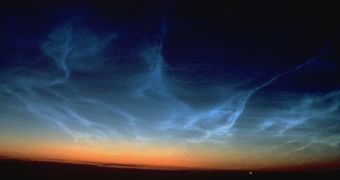Recent calculations performed by a US plasma physicist suggest that noctilucent clouds do not bounce off radar signals because of their silver plating, but because of their, albeit small, metal content.
Blue polar mesospheric clouds, as the late twilight residents are sometimes called, form at the boundaries between atmosphere and outer space, mostly during summer time. Although they initially appeared only at arctic northern latitudes, as of late, they have increasingly been spotted far to the south. Among their many secrets, there is the ability to deflect radar signals, originally associated to the charged particles in their composition, according to opinions such as David Rusch’s from the Laboratory for Atmospheric and Space Physics at the University of Colorado, one of the investigators participating in a NASA program called AIM, focused on the research of noctilucent clouds.
But plasma expert Paul Bellan from Caltech's latest mathematical calculations prove Rusch wrong as he compares the ice-filled clouds' radar signatures to those of a thin metal layer. This tiny metal coating of the ice particles would be ensured by the iron and sodium originating from the constant micrometeoroid impacts with our planet's atmosphere. As he says, “It's possible that there could be a mono-coating. I think we're a little bit skeptical at this point, but we're certainly going to look at it. There's good thinking in that research”. The previous studies on this matter demonstrated that 80% of the metallic vapors in the atmosphere are depleted when the mesospheric clouds appear, which drove Bellan to think that “the ice is like flypaper for the sodium”.
“Ripples in the cloud of metal-coated ice grains reflect in unison and reinforce each other [...] like an army marching in step across a bridge causes the bridge to vibrate,” explains Bellan. “The metal is responsible for the reflectivity. I did the math.”

 14 DAY TRIAL //
14 DAY TRIAL //